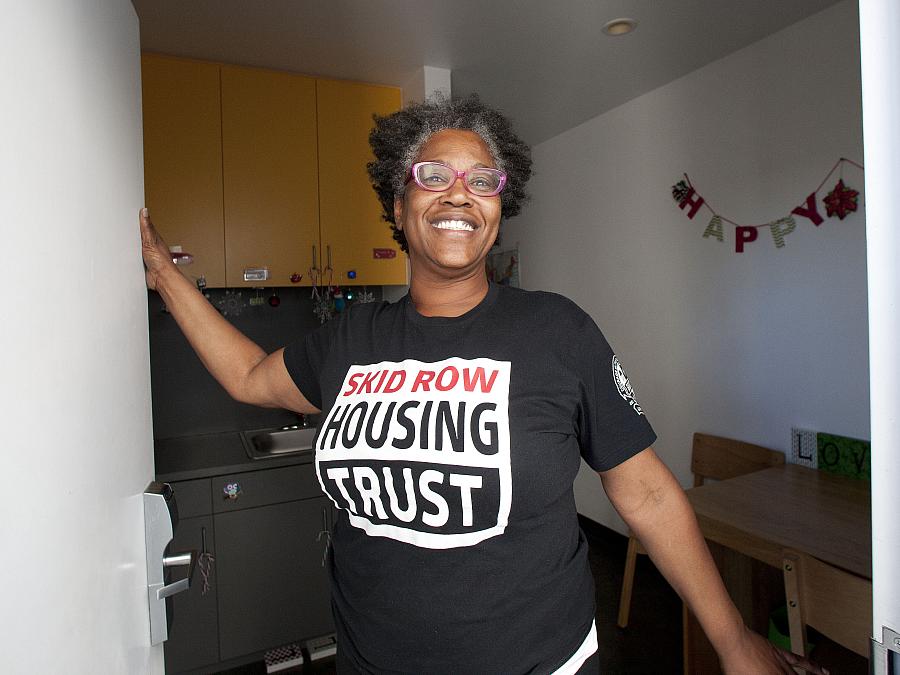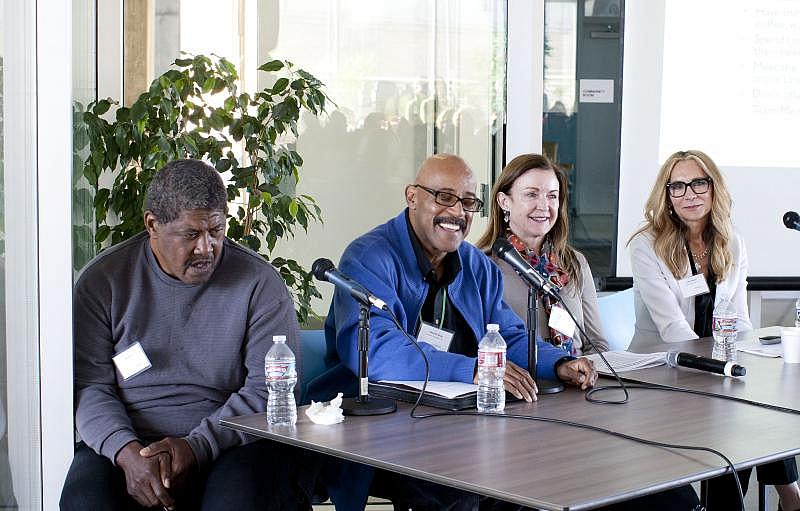Can L.A.'s effort to get homeless into housing match the scale of the problem?

Evelyn Hilliard, formerly homeless on Skid Row, greets visitors at her studio in Star Apartments.
If you’ve followed the policy conversation on homelessness in recent years, you’ll know that “housing first” has become a mantra of sorts. Homeless advocates and public health officials increasingly stress the idea that getting people off the streets into supportive housing is a necessary first step that allows people to then seek help for substance abuse, mental illness and other chronic health issues.
Star Apartments in Los Angeles’ infamous Skid Row is an eye-popping example of what such supportive housing can look like. Community organizations and local government agencies teamed with a famous architect to build more than 100 units of housing at the geographical epicenter of California’s homeless crisis. Completed in 2013 at a cost of $40 million, the building’s prefab modules rise up from their ragged surrounds in stair-step fashion. Six stories offer a bevy of tidy studios, a healthcare clinic, a community garden and kitchen, running track, lounge space and perhaps most importantly, a sense of shelter and dignity for its formerly homeless residents.
California journalists taking part in the Center for Health Journalism's 2016 California Fellowship toured the development this week and heard from several advocates, including Sharon Rapport, associate director for California policy at the Corporation for Supportive Housing, who said the leading approach on curbing homelessness has moved away from earlier decades’ emphasis on sobriety and shelters first, followed by transitional housing.
“In the’ 80s and ’90s, that was our response to homelessness: Let’s get people in the shelter,” Rapport told Fellows. “If they make it in the shelter long enough, we’ll get them into transitional housing. If they make it in transitional housing, they can move onto to a permanent place to live. That was our response for about 20 years while homelessness really expanded. Now we know that is not the right approach.”
Instead, what’s known as “permanent supportive housing” focuses on getting homeless people into long-term housing as quickly as possible, where a case manager works with them to get the health and social services they need to stay off the street. Proponents say the combination of rent subsidies and intensive services is still far cheaper than the alternative of chronic ER visits, jail stints and untreated addiction. Homeless Medicaid recipients in California cost on average over $21,500 a year, according to Rapport, which is nearly double that of a regular Medicaid enrollee. For homeless people with substance abuse problems, that figure can triple, she said.
Yet even with more effective policies that emphasize housing, the scale of the problem can seem daunting. An estimated 45,000 people are homeless in Los Angeles, and Skid Row alone has more than 2,500 people living on the streets. Building tens of thousands of county-owned and operated units like those at Star Apartments is an unlikely solution. “This stuff is beautiful, but it’s very expensive, and it’s very slow,” said Marc Trotz, director of Los Angeles County’s Housing for Health program, who has been charged with replicating San Francisco’s housing-first successes on a much larger scale in L.A.
That hasn’t been easy. Trotz spoke candidly about his frustrations with the pace of progress: “The rate in which people get housing in most communities, and especially in L.A., is nowhere at the scale that anyone would notice,” he said. “We all think we’re doing great, we’re patting ourselves on the back at various housing openings, but the fact is … in reality, we’re not really getting anywhere. We’re not making a difference. Skid Row is getting worse. There are more homeless people.”
Trotz doesn’t cast the problem as a lack of housing. “It’s my opinion that the vast majority of people we house are going to be in private market housing,” he said. “I really do believe there’s a housing solution right now for everyone who’s homeless.”

The rub, of course, lies in finding a way to pay for the all that subsidized housing. “You can’t house a homeless person without a rent subsidy, any way you slice it,” Trotz said. In the face of restricted federal dollars, Los Angeles County has created it’s own rent subsidy program to get the Department of Health Services’ highest-need patients into housing. The goal is to keep doubling the number housed every year until 10,000 of the county’s sickest homeless are in supportive housing.
It’s the job of outreach workers such as Maurice Gray, a case manager with Exodus Recovery, to connect many of those severely ill homeless patients with housing and services. It takes time. Building up trust with homeless clients often entails months of daily visits, small offers of hot coffee or a sandwich and a dogged refusal to give up on those who rebuff repeated offers of help. “If you build up relationship and rapport, nine times out of 10 they’ll come with you,” Gray said. “Our main goal is to get them off the street.”
For Gray and his colleagues in the trenches, fighting homelessness isn’t an abstraction. It’s built on individual relationships, daily interactions, lives thwarted and hopes rekindled. Gray makes a practice of imagining his clients’ earlier selves, before everything went wrong:
“When I look at individuals, you know what I see? I see this little baby. I see this little infant. What happened? Why did it happen? When did happen? That’s empathy. My heart goes out to them. No questions asked. Let me try do what I can do right now — let me try to help them develop skills to where they can empower themselves in the days to come.”
[Photos by Armando Arorizo/CHJ]
